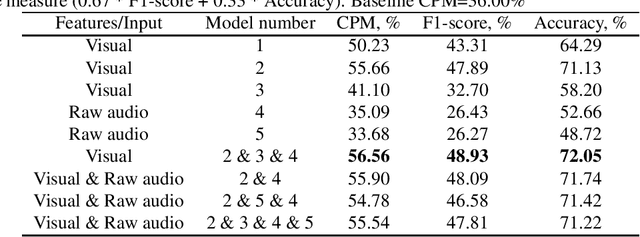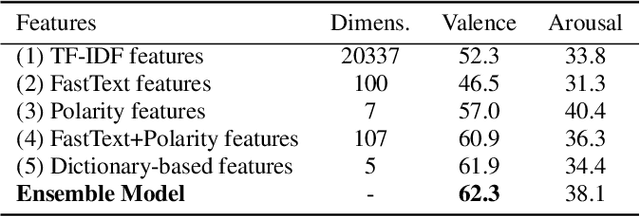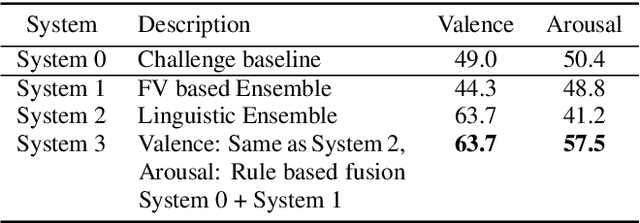Alexey Karpov
Audio-Visual Compound Expression Recognition Method based on Late Modality Fusion and Rule-based Decision
Mar 29, 2024Abstract:This paper presents the results of the SUN team for the Compound Expressions Recognition Challenge of the 6th ABAW Competition. We propose a novel audio-visual method for compound expression recognition. Our method relies on emotion recognition models that fuse modalities at the emotion probability level, while decisions regarding the prediction of compound expressions are based on predefined rules. Notably, our method does not use any training data specific to the target task. Thus, the problem is a zero-shot classification task. The method is evaluated in multi-corpus training and cross-corpus validation setups. Using our proposed method is achieved an F1-score value equals to 22.01% on the C-EXPR-DB test subset. Our findings from the challenge demonstrate that the proposed method can potentially form a basis for developing intelligent tools for annotating audio-visual data in the context of human's basic and compound emotions.
SUN Team's Contribution to ABAW 2024 Competition: Audio-visual Valence-Arousal Estimation and Expression Recognition
Mar 19, 2024Abstract:As emotions play a central role in human communication, automatic emotion recognition has attracted increasing attention in the last two decades. While multimodal systems enjoy high performances on lab-controlled data, they are still far from providing ecological validity on non-lab-controlled, namely 'in-the-wild' data. This work investigates audiovisual deep learning approaches for emotion recognition in-the-wild problem. We particularly explore the effectiveness of architectures based on fine-tuned Convolutional Neural Networks (CNN) and Public Dimensional Emotion Model (PDEM), for video and audio modality, respectively. We compare alternative temporal modeling and fusion strategies using the embeddings from these multi-stage trained modality-specific Deep Neural Networks (DNN). We report results on the AffWild2 dataset under Affective Behavior Analysis in-the-Wild 2024 (ABAW'24) challenge protocol.
An Audio-Video Deep and Transfer Learning Framework for Multimodal Emotion Recognition in the wild
Oct 20, 2020
Abstract:In this paper, we present our contribution to ABAW facial expression challenge. We report the proposed system and the official challenge results adhering to the challenge protocol. Using end-to-end deep learning and benefiting from transfer learning approaches, we reached a test set challenge performance measure of 42.10%.
Is Everything Fine, Grandma? Acoustic and Linguistic Modeling for Robust Elderly Speech Emotion Recognition
Sep 07, 2020


Abstract:Acoustic and linguistic analysis for elderly emotion recognition is an under-studied and challenging research direction, but essential for the creation of digital assistants for the elderly, as well as unobtrusive telemonitoring of elderly in their residences for mental healthcare purposes. This paper presents our contribution to the INTERSPEECH 2020 Computational Paralinguistics Challenge (ComParE) - Elderly Emotion Sub-Challenge, which is comprised of two ternary classification tasks for arousal and valence recognition. We propose a bi-modal framework, where these tasks are modeled using state-of-the-art acoustic and linguistic features, respectively. In this study, we demonstrate that exploiting task-specific dictionaries and resources can boost the performance of linguistic models, when the amount of labeled data is small. Observing a high mismatch between development and test set performances of various models, we also propose alternative training and decision fusion strategies to better estimate and improve the generalization performance.
 Add to Chrome
Add to Chrome Add to Firefox
Add to Firefox Add to Edge
Add to Edge